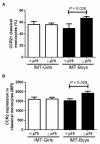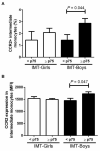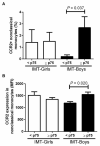The CCR2+ Monocyte Subsets Increase in Obese Boys but Not Girls with Abnormally High Carotid Intima-Media Thickness: A Pilot Study
- PMID: 36286282
- PMCID: PMC9604509
- DOI: 10.3390/jcdd9100330
The CCR2+ Monocyte Subsets Increase in Obese Boys but Not Girls with Abnormally High Carotid Intima-Media Thickness: A Pilot Study
Abstract
The differential contribution of monocyte subsets expressing the C-C chemokine receptor 2 (CCR2) to subclinical atherosclerosis in girls and boys is unclear. In this pilot study, we compared classical, intermediate, and nonclassical monocyte subsets expressing CCR2 in 33 obese children of both sexes aged 8 to 16 divided by carotid intima-media thickness (IMT), considering values above the 75th percentile (p75) as abnormally high IMT. Obesity was defined as body mass index above the 95th percentile according to age and sex. Flow cytometry analyses revealed that boys but not girls with IMT ≥ p75 displayed increased CCR2+ cell percentage and CCR2 expression in the three monocyte subsets, compared to boys with IMT < p75. The CCR2+ cell percentage and CCR2 expression in the three monocyte subsets significantly correlated with increased IMT and insulin resistance in boys but not girls, where the CCR2+ nonclassical monocyte percentage had the strongest associations (r = 0.73 and r = 0.72, respectively). The role of CCR2+ monocyte subpopulations in identifying an abnormally high IMT shows a marked sexual dimorphism, where boys seem to be at higher subclinical atherosclerosis risk than girls.
Keywords: CCR2; children; insulin resistance; intima-media thickness; nonclassical monocytes; obesity.
Conflict of interest statement
The authors declare no conflict of interest. The funders had no role in the design of the study; in the collection, analyses, or interpretation of data; in the writing of the manuscript; or in the decision to publish the results.
Figures




Similar articles
-
Expression of monocyte subsets and angiogenic markers in relation to carotid plaque neovascularization in patients with pre-existing coronary artery disease and carotid stenosis.Ann Med. 2014 Nov;46(7):530-8. doi: 10.3109/07853890.2014.931101. Epub 2014 Jul 11. Ann Med. 2014. PMID: 25012963
-
Heterogeneity of peripheral blood monocytes, endothelial dysfunction and subclinical atherosclerosis in patients with systemic lupus erythematosus.Lupus. 2016 Jan;25(1):18-27. doi: 10.1177/0961203315598014. Epub 2015 Aug 6. Lupus. 2016. PMID: 26251402 Free PMC article.
-
Monocyte heterogeneity in obesity and subclinical atherosclerosis.Eur Heart J. 2010 Feb;31(3):369-76. doi: 10.1093/eurheartj/ehp308. Epub 2009 Aug 17. Eur Heart J. 2010. PMID: 19687164
-
Differential expression of CCR2 and CX3CR1 on CD16+ monocyte subsets is associated with asthma severity.Allergy Asthma Clin Immunol. 2019 Nov 4;15:64. doi: 10.1186/s13223-019-0379-5. eCollection 2019. Allergy Asthma Clin Immunol. 2019. PMID: 31700522 Free PMC article.
-
Monocyte subtypes and the CCR2 chemokine receptor in cardiovascular disease.Clin Sci (Lond). 2017 Jun 1;131(12):1215-1224. doi: 10.1042/CS20170009. Clin Sci (Lond). 2017. PMID: 28566450 Review.
Cited by
-
A Missing Puzzle in Preclinical Studies-Are CCR2, CCR5, and Their Ligands' Roles Similar in Obesity-Induced Hypersensitivity and Diabetic Neuropathy?-Evidence from Rodent Models and Clinical Studies.Int J Mol Sci. 2024 Oct 21;25(20):11323. doi: 10.3390/ijms252011323. Int J Mol Sci. 2024. PMID: 39457105 Free PMC article. Review.
-
Influence of adiposity and sex on SARS-CoV-2 antibody response in vaccinated university students: A cross-sectional ESFUERSO study.PLOS Glob Public Health. 2024 Jul 26;4(7):e0002686. doi: 10.1371/journal.pgph.0002686. eCollection 2024. PLOS Glob Public Health. 2024. PMID: 39058698 Free PMC article.
-
Plasma Leptin Levels, Obstructive Sleep Apnea Syndrome, and Diabetes Are Associated with Obesity-Related Alterations of Peripheral Blood Monocyte Subsets.Immunohorizons. 2023 Mar 1;7(3):191-199. doi: 10.4049/immunohorizons.2300009. Immunohorizons. 2023. PMID: 36921085 Free PMC article.
References
-
- GBD 2015 Obesity Collaborators. Afshin A., Forouzanfar M.H., Reitsma M.B., Sur P., Estep K., Lee A., Marczak L., Mokdad A.H., Moradi-Lakeh M., et al. Health Effects of Overweight and Obesity in 195 Countries over 25 Years. N. Engl. J. Med. 2017;377:13–27. doi: 10.1056/NEJMoa1614362. - DOI - PMC - PubMed
Grants and funding
LinkOut - more resources
Full Text Sources
Research Materials

